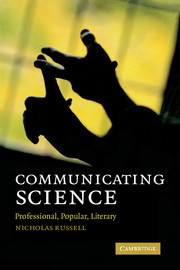Book contents
- Frontmatter
- Contents
- Introduction: What this book is about and why you might want to read it
- Prologue: Three orphans share a common paternity: professional science communication, popular journalism and literary fiction are not as separate as they seem
- Part I Professional science communication
- Part II Science for the public: what science do people need and how might they get it?
- 6 The public understanding of science (PUS) movement and its problems
- 7 Public engagement with science and technology (PEST): good principle, difficult practice
- 8 Citizen scientists? Democratic input into science policy
- 9 Teaching and learning science in school: implications for popular science communication
- Part III Popular science communication: the press and broadcasting
- Part IV The origins of science in cultural context: five historic dramas
- Part V Science in literature
- Index
- References
7 - Public engagement with science and technology (PEST): good principle, difficult practice
Published online by Cambridge University Press: 02 December 2010
- Frontmatter
- Contents
- Introduction: What this book is about and why you might want to read it
- Prologue: Three orphans share a common paternity: professional science communication, popular journalism and literary fiction are not as separate as they seem
- Part I Professional science communication
- Part II Science for the public: what science do people need and how might they get it?
- 6 The public understanding of science (PUS) movement and its problems
- 7 Public engagement with science and technology (PEST): good principle, difficult practice
- 8 Citizen scientists? Democratic input into science policy
- 9 Teaching and learning science in school: implications for popular science communication
- Part III Popular science communication: the press and broadcasting
- Part IV The origins of science in cultural context: five historic dramas
- Part V Science in literature
- Index
- References
Summary
A GARDEN IN SUBURBAN HERTFORDSHIRE, JANUARY
Stage whisper, “There's a greenfinch!” from Emma.
“Oh kid sister, I don't think so,” from Rob the worldly-wise 12-year-old.
“I'm sure it is,” from Emma louder.
“Hush up Emma, you've frightened it,” from dad, “It's flown off.”
“Not a greenfinch though dad, eh – Emma gets so excited.”
“Rob, I think she was right, mark it on the chart.”
Rob tried to ignore his sister's sarcastically extended tongue, realizing for the first time just how cold he was, notwithstanding two sweaters, windcheater and bobble hat after standing still for three-quarters of an hour behind a bush. He had spotted the first robin and the only coal tit, but yielding the most exotic tickbox of the afternoon to Emma was almost too much to bear.
A KITCHEN TABLE IN RURAL SOUTH DEVON, JULY
Len: “I ought to walk as far as the copse more often.”
Jo: “Only if you're careful, the ground's uneven and you nearly fell last week.”
Len: “Don't fuss, I was fine with the new stick. Best thing though was a definite stag beetle on that pile of old logs by the lightning oak. That's the second this year.”
Jo: “Isn't it three or four? Didn't Matt see some when he was here?”
Len: “I'm not sure with young Matt, he's claimed to have seen an eagle in the garden before now, I think maybe he saw Cockchafers because there were lots of them flying in the evening when he was here. […]
- Type
- Chapter
- Information
- Communicating ScienceProfessional, Popular, Literary, pp. 83 - 98Publisher: Cambridge University PressPrint publication year: 2009



